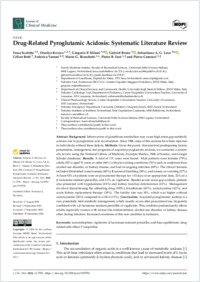Drug-related pyroglutamic acidosis : systematic literature review
- Scafetta, Tessa Institute of Family Medicine, Faculty of Biomedical Sciences, Università della Svizzera italiana, Switzerland
- Kovacs, Orsolya Institute of Family Medicine, Faculty of Biomedical Sciences, Università della Svizzera italiana, Switzerland - Department of Anesthesia, Hôpital du Valais, Sion, Switzerland
- Milani, Gregorio P. Pediatric Unit, Fondazione IRCCS Ca’ Granda Ospedale Maggiore Policlinico, Milan, Italy - Department of Clinical Sciences and Community Health, Università degli Studi di Milano, Italy
- Bronz, Gabriel ORCID Institute of Family Medicine, Faculty of Biomedical Sciences, Università della Svizzera italiana, Switzerland
- Lava, Sebastiano A. G. Pediatric Cardiology Unit, Department of Pediatrics, Centre Hospitalier Universitaire Vaudois, University of Lausanne, Switzerland - Clinical Pharmacology Service, Centre Hospitalier Universitaire Vaudois, University of Lausanne, Switzerland
- Betti, Céline Pediatric Emergency Department, University Children’s Hospital Zurich, Switzerland
- Vanoni, Federica Pediatric Institute of Southern Switzerland, Ente Ospedaliero Cantonale, Bellinzona, Switzerland - Faculty of Biomedical Sciences, Università della Svizzera italiana, Switzerland
- Bianchetti, Mario G. ORCID Institute of Family Medicine, Faculty of Biomedical Sciences, Università della Svizzera italiana, Switzerland
- Faré, Pietro B. ORCID Institute of Family Medicine, Faculty of Biomedical Sciences, Università della Svizzera italiana, Switzerland
- Camozzi, Pietro Department of Anesthesia, Hôpital du Valais, Sion, Switzerland
- 2024
Published in:
- Journal of Clinical Medicine. - 2024, vol. 13, p. 5781
Acetaminophen
Vigabatrin
β-lactamase-resistant penicillin
Acid base equilibrium
Drug-related side effect
5-oxoproline
English
Background: Inborn errors of glutathione metabolism may cause high anion gap metabolic acidosis due to pyroglutamic acid accumulation. Since 1988, cases of this acidosis have been reported in individuals without these defects. Methods: Given the poorly characterized predisposing factors, presentation, management, and prognosis of acquired pyroglutamic acidosis, we conducted a systematic review using the National Library of Medicine, Excerpta Medica, Web of Science, and Google Scholar databases. Results: A total of 131 cases were found. Most patients were females (79%), adults (92%) aged 51 years or older (66%) with pre-existing conditions (74%) such as undernutrition, alcohol-use disorder, or kidney disease, and had an ongoing infection (69%). The clinical features included diminished consciousness (60%), Kussmaul breathing (56%), and nausea or vomiting (27%). At least 92% of patients were on paracetamol therapy for >10 days at an appropriate dose, 32% on a β-lactamase-resistant penicillin, and 2.3% on vigabatrin. Besides severe anion gap acidosis, patients also presented with hypokalemia (24%) and kidney function deterioration (41%). Management involved discontinuing the offending drug (100%), bicarbonate (63%), acetylcysteine (42%), and acute kidney replacement therapy (18%). The fatality rate was 18%, which was higher without acetylcysteine (24%) compared to with it (11%). Conclusions: Acquired pyroglutamic acidosis is a rare, potentially fatal metabolic derangement, which usually occurs after paracetamol use, frequently combined with a β-lactamase-resistant penicillin or vigabatrin. This condition predominantly affects adults, especially women with factors like undernutrition, alcohol-use disorder, or kidney disease, often during infection. Increased awareness of this rare condition is necessary.
- Collections
- Language
-
- English
- Classification
- Medicine
- License
- Open access status
- gold
- Identifiers
-
- DOI 10.3390/jcm13195781
- ARK ark:/12658/srd1331831
- Persistent URL
- https://n2t.net/ark:/12658/srd1331831
Statistics
Document views: 66
File downloads:
- Bianchetti_2024_MDPI_jcm_Drug-Related Pyroglutamic Acidosis: 19
